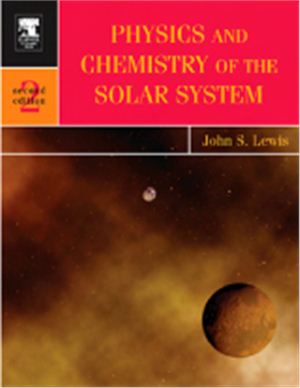Second edition, Academic Press, Elsevier, Inc., Amsterdam, London,
New York, 2004, 671 pp. - ISBN 0-12-446744-X
At its original conception, this book was based on the structure, scope, and philosophy of a sophomore/ junior level course taught at M.I.T. by the author and Prof. Irwin I. Shapiro from 1969 to 1982. Although the content of that course varied greatly over the years in response to the vast new knowledge of the Solar System provided by mode Earth-based and spacecraft-based experimental techniques, the philosophy and level of presentation remained very much the same. The material was brought up to date in 1994 for publication in 1995, and again updated with many corrections and additions for a revised edition in 1997. This second edition was prepared in 2002 to take advantage of the many recent advances in the study of Mars and small Solar System bodies, the discovery and study of more than 100 extra-solar planets, and more mature analysis of the Galileo Orbiter and probe data on Jupiter and its large satellites.
Contents.
Foreword.
Introduction.
Astronomical Perspective.
General Description of the Solar System.
The Sun and the Solar Nebula.
The Major Planets.
Pluto and the Icy Satellites of the Outer Planets.
Comets and Meteors.
Meteorites and Asteroids.
The Airless Rocky Bodies: Io, Phobos, Deimos, the Moon, and Mercury.
The Terrestrial Planets: Mars, Venus, and Earth.
Planets and Life around Other Stars.
Future Prospects.
Appendix.
Index.
At its original conception, this book was based on the structure, scope, and philosophy of a sophomore/ junior level course taught at M.I.T. by the author and Prof. Irwin I. Shapiro from 1969 to 1982. Although the content of that course varied greatly over the years in response to the vast new knowledge of the Solar System provided by mode Earth-based and spacecraft-based experimental techniques, the philosophy and level of presentation remained very much the same. The material was brought up to date in 1994 for publication in 1995, and again updated with many corrections and additions for a revised edition in 1997. This second edition was prepared in 2002 to take advantage of the many recent advances in the study of Mars and small Solar System bodies, the discovery and study of more than 100 extra-solar planets, and more mature analysis of the Galileo Orbiter and probe data on Jupiter and its large satellites.
Contents.
Foreword.
Introduction.
Astronomical Perspective.
General Description of the Solar System.
The Sun and the Solar Nebula.
The Major Planets.
Pluto and the Icy Satellites of the Outer Planets.
Comets and Meteors.
Meteorites and Asteroids.
The Airless Rocky Bodies: Io, Phobos, Deimos, the Moon, and Mercury.
The Terrestrial Planets: Mars, Venus, and Earth.
Planets and Life around Other Stars.
Future Prospects.
Appendix.
Index.

